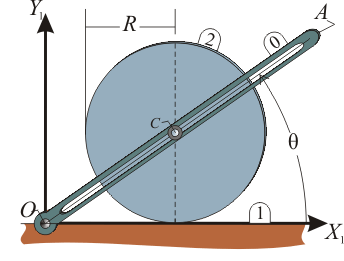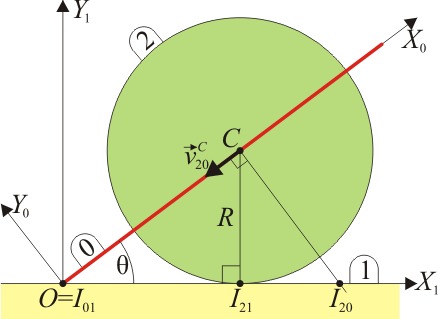6.6. Disco en manivela ranurada
De Laplace
Contenido |
1 Enunciado
El sistema de la figura está constituido por un plano vertical fijo OX1Y1 (sólido “1”) que en todo instante contiene a otros dos sólidos en movimiento: un disco de radio R y centro C (sólido “2”), que rueda sin deslizar sobre el eje horizontal OX1; y una manivela ranurada OA (sólido “0”), que es obligada a girar con velocidad angular constante Ω alrededor de un eje permanente de rotación que pasa por el punto O y es perpendicular al plano fijo definido como sólido “1” (eje OZ1). Los movimientos de ambos sólidos se hallan vinculados entre sí porque el centro C del disco está obligado a deslizar en todo instante a lo largo de la ranura de la manivela.
Considerando el movimiento {20} como el movimiento problema, se pide:
- Haciendo uso de procedimientos gráficos, determinar la posición del CIR de dicho movimiento {20}.
- Utilizando como parámetro geométrico el ángulo θ indicado en la figura, obtener la reducción cinemática del movimiento {20} en el punto C,
 .
.
- Clasificar el movimiento {20} en el instante en que θ = π / 2 especificando si se trata de rotación, traslación, movimiento helicoidal o reposo.

2 Posición del CIR
Por el teorema de los tres centros, el CIR I20 debe estar alineado con el I21 y el I01.
Por tratarse de una rodadura sin deslizamiento, el CIR del movimiento {21} es el punto de contacto de la rueda con el eje horizontal.
El CIR del movimiento {01} es el punto O, de articulación de la manivela con el eje.
Por estar alineado con estos dos, el CIR del movimiento {20} debe encontrarse sobre el eje horizontal OX1. Queda por determinar dónde exactamente.
El vínculo de que el centro C del disco se encuentre sobre la manivela obliga a que la velocidad del punto C en el movimiento {20} sea necesariamente a lo largo de ésta. Puesto que el CIR se encuentra sobre la recta que pasa por C y es perpendicular a la velocidad  basta con trazar la perpendicular a la manivela en C. El punto donde esta recta corta al eje OX1 es el CIR I20.
basta con trazar la perpendicular a la manivela en C. El punto donde esta recta corta al eje OX1 es el CIR I20.
El vector de posición de este punto será de la forma

El valor de x lo obtenemos aplicando trigonometría. El segmento OI20 es la hipotenusa de un triángulo rectángulo cuyo cateto contiguo es OC. Por tanto

A su vez OC es la hipotenusa de un triángulo rectángulo cuyo cateto opuesto mide R, el radio del disco

Por tanto

3 Reducción cinemática
3.1 Directamente
3.1.1 Velocidad
La velocidad de C la podemos hallar derivando el vector de posición en un sistema de referencia “0” ligado a la manivela. Tomando como eje OX0 el que va a lo largo de la manivela, el vector de posición relativo es

Derivando en esta expresión

3.1.2 Velocidad angular
Puesto que conocemos la posición del CIR I20 podemos hallar la velocidad angular empleando la relación

El vector de posición relativo desde el CIR va en la dirección del eje OY0 y tiene por módulo el cateto opuesto de un triángulo rectángulo

Por tanto,

Despejando

3.1.3 Expresión de la reducción cinemática
Reuniendo los dos resultados obtenemos la reducción cinemática

Empleando la base ligada al sólido “1”, esto queda

3.2 Por composición de movimientos
3.2.1 Velocidad
Alternativamente, podemos obtener la velocidad de C empleando la fórmula de composición de velocidades

La velocidad en el movimiento {01} corresponde a una rotación alrededor de O

siendo su velocidad angular

y el vector de posición

lo que nos da la velocidad

La velocidad de C en el movimiento {21} la podemos hallar derivando la posición en el sistema “1”, que conocemos en todo momento

Resulta una velocidad horizontal como corresponde a que el punto C se desplaza paralelamente al eje OX1.
Componiendo las dos velocidades

3.2.2 Velocidad angular
Igualmente, podemos hallar la velocidad angular del movimiento {20} como

siendo

La velocidad angular del movimiento {21} la podemos hallar a partir de la velocidad de C

Igualando esta expresión a la velocidad lineal calculada anteriormente y despejando queda

Llevando esto a la fórmula de composición de velocidades angulares, llegamos a

Reuniendo la velocidad y la velocidad angular nos queda la misma reducción cinemática que ya expresamos anteriormente.
4 Tipo de movimiento
Cuando θ = π / 2, la reducción cinemática se reduce a

y por tanto el disco se encuentra instantáneamente en reposo respecto a la manivela.






